What is a Facet Joint?
Humans enjoy an incredible spinal range of motion. The ability to bend and twist is largely a function of the facet joints, which are thumb-nail sized joints located up and down the spine.
At every level of the cervical, thoracic, and lumbar spine, there are two facet joints (right

Every Spinal Level has a Facet Joint on Both Sides
and left). They contain articular cartilage similar to the knee, hip and shoulder, and normally each one allows for pain free movement in numerous directions. Unfortunately, facet joints are prone to arthritis like other weight bearing joints of the body.
Facet joints have a much smaller surface area than a person’s hip or knee joints. So one might think arthritis in a facet joint would not hurt as much as the larger joints. But this is a myth, as the pain from an arthritic facet joint can be disabling as well. A lot of body weight goes through each of the facet joints, and the pain in an arthritic joint may be severe.
In addition, when a person has arthritis in one facet joint, there is often arthritis and pain in multiple. This makes it a more complicated problem than dealing with an arthritis problem in one knee or hip. There are over 40 facet joints, and only two knees!
Why do facet joints develop arthritis?
As weight bearing joints, facet joints contain articular cartilage and a joint capsule just like a hip or knee. These joints are prone to degenerative osteoarthritis (wear and tear arthritis) similar to the extremities. The mechanisms of how degenerative arthritis develops is not completely understood, however, it is known that as people age cartilage is still formed but the rate of degeneration increases. So the ratio of cartilage formation to degeneration becomes a mismatch.

The facet joints are about the size of a thumbnail.
When an individual sustains trauma to the facet joints, post-traumatic arthritis can set in. A classic example of this is a whiplash injury to the neck. The facet joints see considerable force during a whiplash injury, and the cartilage in the cervical facet joints often sustain injury. This may heal somewhat, but often leads to an arthritis problem down the road and potentially chronic neck pain. The same problem can be seen in the lumbar spine after a car accident, sports injury, etc.
Call (602) 507 – 6550 to schedule your Appointment TODAY!

How is facet arthritis diagnosed?
Pain management doctors in Arizona along with chiropractors are very experienced in making the diagnosis of facet joint arthritis. When a patient has significant pain with extension positions and activities, that is a sign of facet arthritis. Physical examination can elucidate some of a person’s pain along with a good history.
X-rays, CT scans, or MRI’s can also show evidence of facet arthritis. It is important to note that simply because arthritis is present on an imaging study does not mean that it is causing the person pain. It may simply be an incidental finding.
If facet arthritis is seen at multiple levels, it may be necessary for the pain doctor to perform medial branch block injections to elucidate the pain generating level(s).
What treatments are available for facet syndrome?
There are quite a few nonsurgical treatments available for facet syndrome pain. Surgery is not a great idea for facet syndrome, as typically multiple joints are involved and a spinal fusion of several levels would be necessary. This increases the surgical risk and decreases the chances of a successful outcome.
Medication management is a first line mainstay of treatment. NSAIDS and Tylenol can be very effective and should be taken according to the manufacturer’s recommendations. Narcotic medications on a chronic basis are not a good idea, but for short term flare-ups are very helpful.
Physical rehabilitation and chiropractic treatment can take pressure off of the arthritic joints and decrease pain. Strengthening the muscles around the spine, including core stabilization with abdominal strengthening, relieves spinal pressure and makes the pain from an arthritic facet joint lessen.
Spinal decompression therapy is a treatment that is FDA cleared and has increased in popularity over the past decade as it is safe, affordable, and effective. The treatment provides intermittent spinal traction that “tricks” the arthritic joints and discs into separating, allowing vital oxygen and nutrients to come in for healing.
Medial branch blocks are a very effective injection that perform two purposes. The first purpose of a medial branch block is a diagnostic one. The injection involves placing numbing medicine around the medial branch nerves, which are the ones providing pain sensation to an arthritic facet joint. If the injection provides pain relief, the level is diagnosed as being a significant pain generator.
As a second purpose, medial branch blocks serve a therapeutic benefit. It has been shown that medial branch blocks provide an average of 3 to 5 months’ pain relief to an arthritic joint, which is an excellent amount of time (Manchikanti et al, 2008).

Facet Joint Injection
If a medial branch block works and eventually wears off, the injection may either be repeated or the pain doctor can perform a radiofrequency ablation. A radiofrequency neurotomy has been shown to provide excellent results in approximately 80% of patients with pain relief lasting 3 months to 2 years (Shealy, 1975, Journal of Neurosurgery).
A different variation of injection is placing steroid directly into the facet joints, similar to an injection into a knee joint of cortisone. The facet joints are much smaller than a knee, and with arthritis and bony overgrowth it can be difficult to obtain entry. However, the effectiveness of these injections has anecdotally been satisfactory. No large studies have been performed on these injections. They may be repeated every few months into the affected joints with a very low complication rate.
How effective is nonoperative treatment for Facet Joint Arthritis?
Nonsurgical treatment of facet syndrome is very effective. Over 90% of those suffering from spinal arthritis will not need spine surgery, and with comprehensive pain management may achieve an excellent low level of baseline pain allowing people to increase physical activity, work better, and play with their kids and loved ones.
Arizona Pain Specialists offers all of these nonsurgical treatments for facet arthritis pain with comprehensive pain management by Award Winning, Board Certified pain doctors. There are multiple locations serving Phoenix, Scottsdale, Glendale, Mesa, Chandler, Surprise, Goodyear, Avondale, Peoria, Sun City, Tempe, Ahwatukee, Gilbert, Queen Creek, Fountain Hills, Laveen, and more.
Call (602) 507 – 6550 to schedule your Appointment TODAY!

![]()




